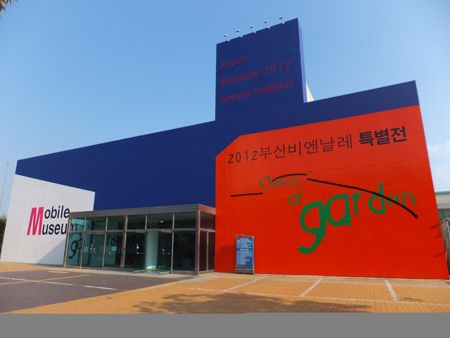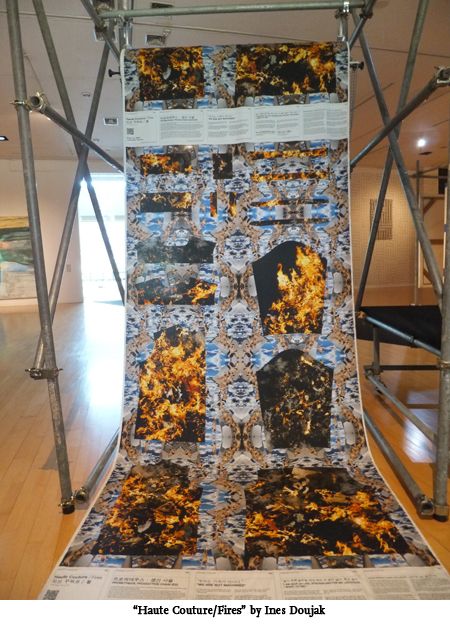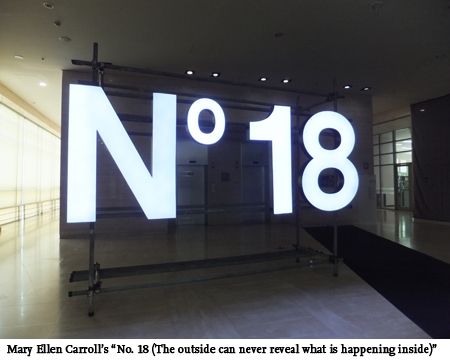Enter ‘Garden of Learning’ in Busan

A view of Busanjin Station, where the special exhibition "Outside of Garden" is being held as part of the 2012 Busan Biennale under way through Nov. 24. / Courtesy of Cathy Rose Garcia
BUSAN — The Busan Museum of Art (BMA) can be easy to miss, next to the enormous BEXCO, department stores and towering buildings. The facade, which has been covered in black fabric squares, may even make one wonder if the museum is open.
But yes, it is open and the building’s eye-catching transformation is part of the Busan Biennale.
The biennale’s main exhibition “Garden of Learning” is at the BMA, while special exhibition “Outside of Garden” is found at different venues, namely Busanjin Station, Busan Cultural Center and Gwangalli Meworld.
This year’s event feels much smaller, more contained, and with less buzz than previous years. Perhaps this is a good thing, since it focuses more on the quality of the art rather than the quantity. Still, there are 330 pieces by 106 artists in the biennale but around 200 are at the BMA.
Artistic director and German curator Roger Buergel says the theme “Garden of Learning” started with his “relative ignorance.”
“What do we wish to know about Korea and about the general audience’s many needs when it comes to Biennale-type exhibitions? Or rather, what do we wish to know about this in terms of an exhibition? In order to answer these questions, Busan Biennale 2012 is mainly conceived by a Learning Council,” Buergel said in the exhibition catalogue.
The Learning Council refers to an open forum with the artistic director, artists and people from Busan and other parts of Korea. For months before the biennale, they discussed the process of creating the exhibition and the result is “Garden of Learning.”
“Entering an artwork in that emphatic sense requires a sacrifice, and this is where every true encounter with art becomes a serious and worthwhile effort that completely contradicts the festival mood of the biennale-type exhibition. Because, much as in the way one has to deposit an umbrella at the museum’s cloakroom, you also have to discard your notion of self-sameness before entering the Garden of Learning. An aesthetic experience is either a transformative experience or it is nothing,” he said.
Garden of Learning
One of the first pieces one sees at the BMA is Jurgen Stollhans’ “Nirvana Fish” made of Oxford blocks, followed by well-worn shoes and paper flowers that are carefully arranged on the floor, as part of Sung Hyo-sook’s “Requiem.” Sung collected shoes from employees of Hanjin, Samsung, GM Korea and other companies, as well as paper flowers that they made.
Mary Ellen Carroll’s “No. 18 (The outside can never reveal what is happening inside)” is an exploration of the Korean building. She rented an apartment in the old area of Jwacheon-dong and activities in the apartment are broadcast via a CCTV video to inside the museum. Visitors can also go to the apartment in Jwacheon if they want.
Carroll also put up sheets of paper printed with dates and news about Korea and Koreans. On one of the pages, it quoted June 19 article “Anti-foreigner groups on the rise” from the The Korea Times: “Korea may be relatively safe for foreigners to live in but some xenophobic groups are becoming more vocal and organized as the number of immigrants rises.”
Mathias Poledna’s “A Village by the Sea” is a nearly 6-minute video showing a man and woman singing a duet, evoking thoughts of a 1930s musical. The song is catchy and may well remain stuck in your head as you go through the museum.
Ham Kyung-ah’s “Odessa Stairs” is a makeshift structure using leftover materials from a luxury renovation of a former Korean president’s villa. She collected odd bits and pieces such as a bamboo tree, pipe, bidet and other items to create the piece, which makes a reference to the massacre scene in “Battleship Potemkin.”
“Korean history is also marked by the massacre following the Gwangju Uprising in 1980, which of course the former President (the same president from whose garbage heap the items were taken) had a hand in. Reading ‘Odessa Stairs’ in this way would turn Haminstallation into a fine memorial. A memorial that is not, as it happens all too often, drowned in its own rhetoric, but is heartfelt and formally accomplished at the same time,” the biennale catalogue read.
Ines Doujak’s “Haute Couture/Fires” explores the textile industry and the people who work in slave-like conditions within it. The textiles are printed with images of naked bodies and fire, inspired by factory fires that have killed many textile workers around the world.
“Her installation sheds light on the perennial circle of exploitation: the young women of Korea, now so nicely dressed, are probably wearing clothes that were cheaply produced in Indonesia, Honduras or the Philippines (likely as not in Korean-owned factories) by women who work under basically the same slavish conditions that their grandmothers did,” the catalogue said.
Norwegian artist Guttorm Guttormsgaard’s “Camera Obscura” features a series of rooms beginning with a completely dark one which casts an image of the world upside down. When one emerges from the room, one can find some 100 objects, prints and books from Guttormsgaard’s collection.
Thomas Bayrle’s “Korean Rosary” features a “wiper machine” or a windshield wiper moving in rhythm to a recording of people praying the rosary.
Japanese artist Takamine Tadasu’s mixed media installation “Baby Insadong” explores the relationship of Zai-nichi or Japanese-Koreans with Japanese and Koreans.
Busanjin Station
One of the special exhibitions is at Busanjin Station, which used to be the main train station in Busan.
The two-story building features three sections “The Mystic Fable — Truths and Fictions of Space” (curated by Kim Ah-ram); “Mobile Museum” (curated by Christina Choi) and “The Cage of Recognition” (curated by Lee Hoon-suk).
The Mobile Museum tries to inject life back into Busanjin Station as a cultural space, showing old photos and reviving memories of the station’s role in Busan’s growth. It opened in 1904 but closed in 2004 due to the introduction of the KTX.
“The Mystic Fable” reinterprets the experience of Busanjin Station through the works by five artists. Peter Sutton’s mixed media installation “A Guide to Busan” recreates the old station office, complete with his own guide to the city.
Sunee Markosov’s “Trainspotting” is a play on the movie of the same name, and encourages visitors to go inside a dark room and watch a window overlooking the train tracks.
The Busan Biennale runs through Nov. 24. The main exhibition is open from 10 a.m. to 8 p.m., while the special exhibitions are open from 10 a.m. to 6 p.m. Tickets are 7,000 won for adults, 4,000 won for student/military/police and 15,000 won for a family of 4. To make it easier to visit the different venues, there are shuttle buses going from the BMA to the other venues on Fridays, weekends and holidays.
Cathy Rose Garcia is a contributing writer for The Korea Times. <The Korea Times/Cathy Rose Garcia>





















































